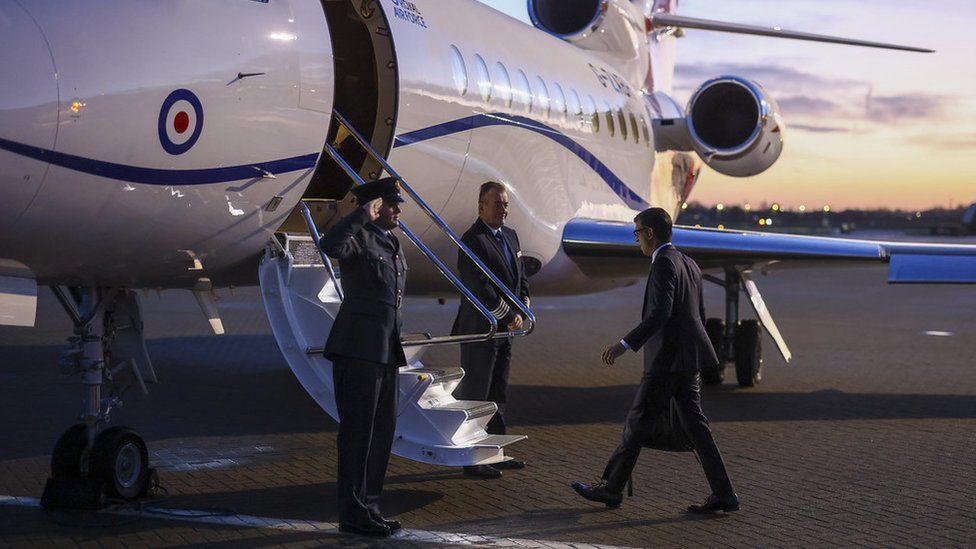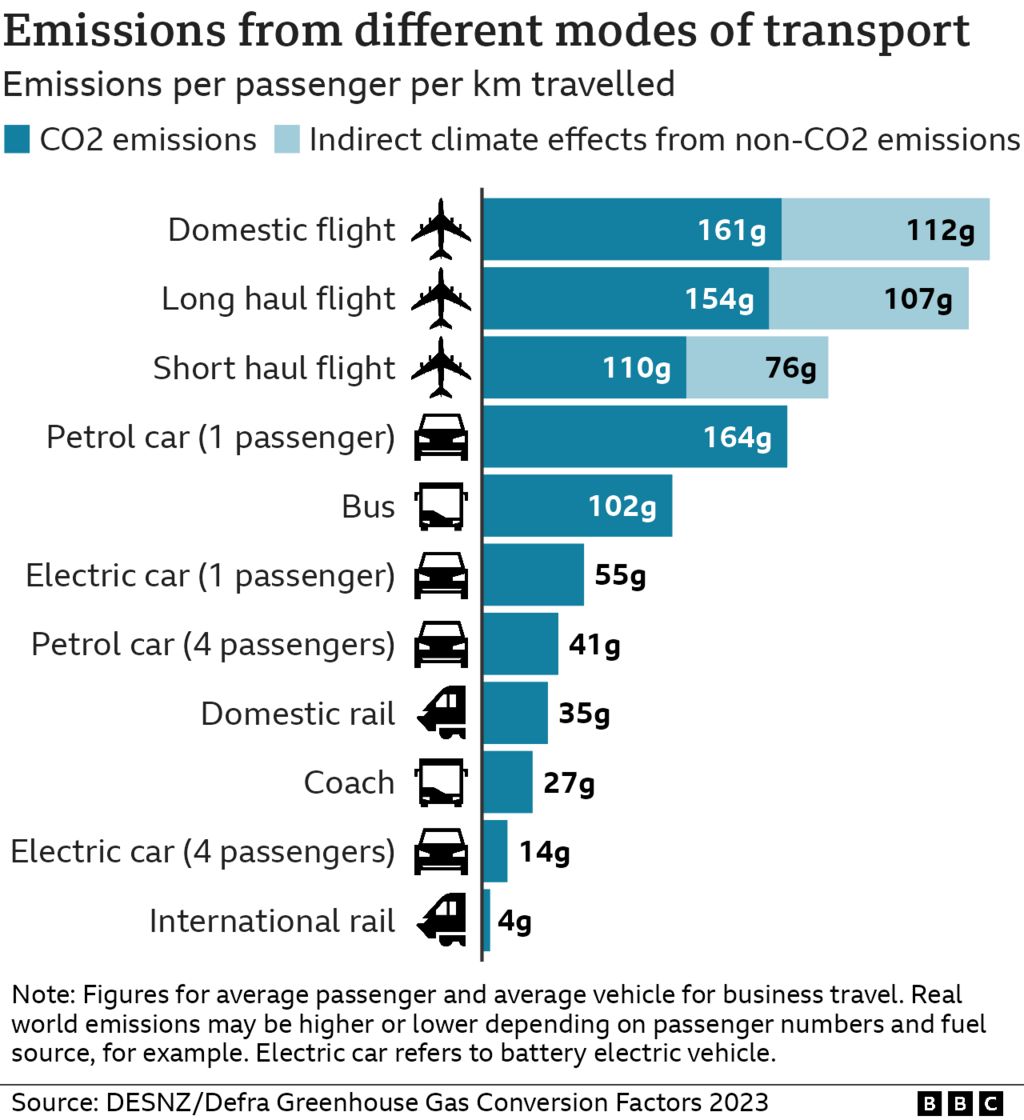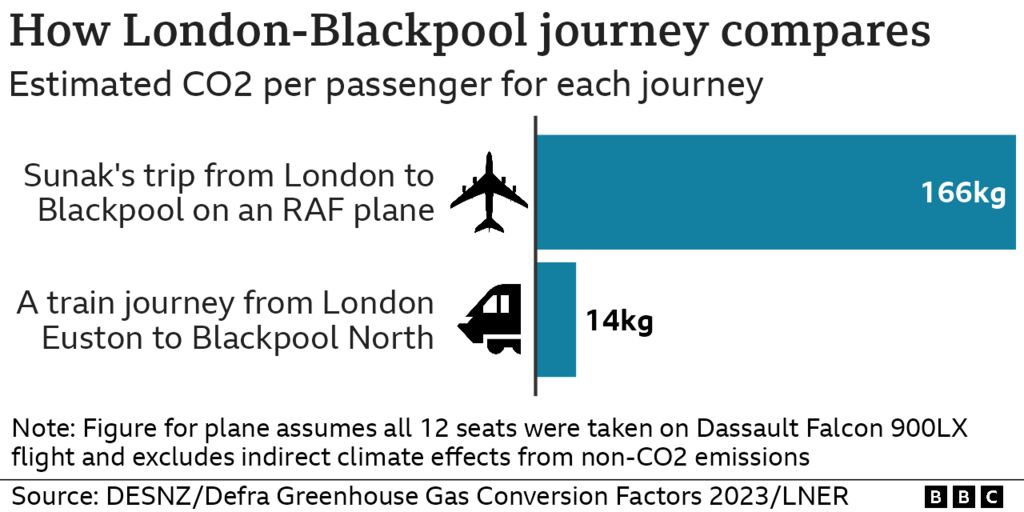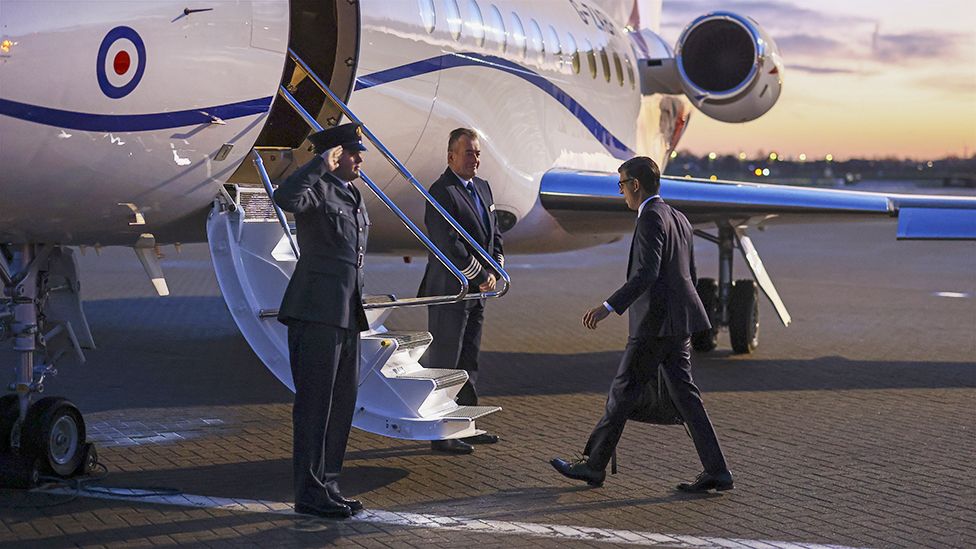Rishi Sunak most frequent UK flyer among recent PMs

Rishi Sunak has used RAF jets and helicopters for domestic flights more frequently than the UK’s previous three prime ministers, the BBC can reveal.
Ministry of Defence data show he took almost one such flight a week during his first seven months in office.
The prime minister has been accused of hypocrisy for flying short journeys domestically, given his pledges to curb planet-warming carbon emissions.
But Mr Sunak has said air travel was the “most effective use of my time”.
In response to Freedom of Information requests, the BBC was told the number of domestic flights on Command Support Air Transport aircraft broken down by prime minister between July 2016 and April 2023.
The RAF division – known as 32 Squadron – operates two Dassault Falcon 900LX jets and a helicopter to transport the PM and other ministers domestically.
- Net zero sceptics warm to Sunak climate shift
- What’s the climate impact of private jets?
- Should we give up flying for the sake of the climate?
In total, Mr Sunak boarded 23 domestic flights on these aircraft in 187 days, which is one every eight days on average.
Two caveats to bear in mind are the brevity of Ms Truss’s time in Downing Street, and the limitations on Mr Johnson’s travel during the Covid-19 pandemic.
The BBC initially requested data on the number of flights each UK prime minister since Tony Blair had taken using a military aircraft to travel domestically. But the MoD rejected the request on cost grounds and advised asking for data on those flights since Mrs May.
The prime minister sometimes has access to an RAF Voyager plane for overseas trips, and the government also charters private flights on aircraft operated by Titan Airways.
Separately, Mr Sunak has accepted more than £70,000 worth of private jet and helicopter travel to Conservative Party events from political donors this year.
High politics
Mr Sunak’s use of flights for UK engagements has come under intense scrutiny, with critics questioning why he had not used the train instead of RAF aircraft for relatively short trips to Newquay, Dover and Leeds this year.
Last month, Mr Sunak said those who say “no one should take a plane” in their approach to climate change were “completely, and utterly wrong”.
Labour said the PM was “developing an expensive habit of swanning around on private jets courtesy of the taxpayer”.
The party’s deputy leader, Angela Rayner, suggested Mr Sunak had breached the ministerial code, which states he is supposed to use scheduled flights, unless “it is essential to travel by air”.


In his speech at the COP27 climate summit last year, Mr Sunak said it was “morally right to honour” the UK’s promise to reduce carbon emissions.
The UK has set a legally binding target of achieving net-zero carbon emissions by 2050, as part of the global effort to avert the worst effects of climate change.
Flights produce greenhouse gases – mainly carbon dioxide (CO2) – from burning fuel, and these emissions contribute to global warming.
Emissions per kilometre travelled from domestic flights are significantly worse than any other form of transport, and private jets typically produce more CO2 than commercial flights.
But carbon emissions vary considerably depending on the size of the plane, how efficient its engines are, and how many passengers it carries.
In 2019, before the pandemic struck, international and domestic UK aviation accounted for 8% of the UK’s total greenhouse gas emissions.
PM’s priorities
Anna Hughes, whose Flight Free UK campaign urges people to fly less for the sake of the climate, said Mr Sunak’s transport choices were “frustrating”.
She said if leaders demonstrated “the kind of behaviour that we all need to adopt to avert the climate crisis, it communicates that it’s serious and real”.
“You can’t just say I’m the prime minister, I’m too busy and important,” she added.


One former official with knowledge of ministerial travel prior to Mr Sunak’s premiership said transport choices “were based on time”, adding the train would be used “nine times out of ten”.
The former official, who did not wish to be named, said they “had access to the PM’s diary and every single minute of every day is accounted for”.
“In order to achieve a long visit, the only way was to use an aircraft,” they said.
A Downing Street spokesperson said ministers “sometimes require the use of non-commercial air travel”.
“This is a standard practice for governments around the world and this has consistently been the case under successive UK administrations of all political colours,” the spokesperson said.
“Value for money, security, and time efficiency is taken into account in all travel decisions and all flights are carbon offset.”
What’s the PM’s carbon footprint?
Although we have the number of domestic flights Mr Sunak has taken up to April this year, we don’t know the details of all those journeys, and what aircraft he used.
We did ask for that information, but the MoD said the “RAF does not retain records for air miles flown by aircraft”, and withheld data on the PM’s trips.
That means we can’t calculate the overall carbon footprint of Mr Sunak’s domestic flights during his first seven months in office.
What we can do is estimate the carbon emissions of some individual flights, using information in the public domain.
For example, on 19 January, the prime minister flew from RAF Northolt in west London to Blackpool Airport on a Dassault Falcon 900LX.


A number of aviation websites say the Falcon has a fuel consumption of about 260 gallons per hour. The flight from London to Blackpool took 41 minutes, which means approximately 178 gallons, or 805 litres, of fuel was consumed.
Based on the government’s fuel-to-emissions conversation rates, the flight would have produced about two tonnes of CO2.
Falcon jets typically have 12 seats. So if we assume the plane was full for the Blackpool trip, two tonnes of CO2 would be 166 kg per person.
To put that into context, the International Energy Agency estimated that the global average energy-related carbon footprint was about 4.7 tonnes of CO2 per person in 2021.
In contrast to Mr Sunak’s flight, a train journey from London Euston to Blackpool North would produce 14.31kg of CO2 per passenger, according to a LNER carbon calculator..
The Trainline website says it takes an average of three hours and 43 minutes to travel from London Euston to Blackpool by train.
Additional reporting by Mark Poynting, BBC climate researcher

Sign up for our morning newsletter and get BBC News in your inbox.

Related Topics
- Rishi Sunak
- Air travel
-
Net zero sceptics warm to Sunak climate shift
-
3 August

-
-
Rishi Sunak: Bans not right approach to net zero
-
28 July

-
-
Rishi Sunak used jet for Leeds hospital visit
-
10 January

-
Published at Thu, 10 Aug 2023 23:28:38 +0000
